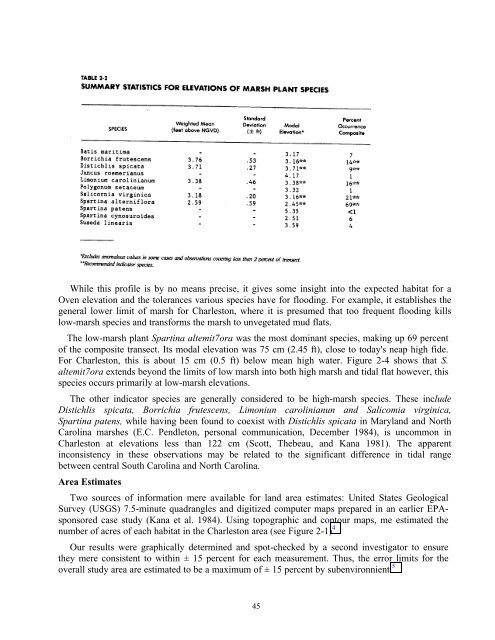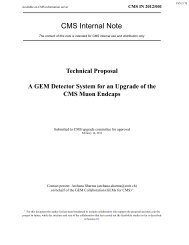Kana et al. 1988. S. Carolina Charleston SLR Case Study
Kana et al. 1988. S. Carolina Charleston SLR Case Study
Kana et al. 1988. S. Carolina Charleston SLR Case Study
Create successful ePaper yourself
Turn your PDF publications into a flip-book with our unique Google optimized e-Paper software.
While this profile is by no means precise, it gives some insight into the expected habitat for a<br />
Oven elevation and the tolerances various species have for flooding. For example, it establishes the<br />
gener<strong>al</strong> lower limit of marsh for <strong>Charleston</strong>, where it is presumed that too frequent flooding kills<br />
low-marsh species and transforms the marsh to unveg<strong>et</strong>ated mud flats.<br />
The low-marsh plant Spartina <strong>al</strong>temit7ora was the most dominant species, making up 69 percent<br />
of the composite transect. Its mod<strong>al</strong> elevation was 75 cm (2.45 ft), close to today's neap high fide.<br />
For <strong>Charleston</strong>, this is about 15 cm (0.5 ft) below mean high water. Figure 2-4 shows that S.<br />
<strong>al</strong>temit7ora extends beyond the limits of low marsh into both high marsh and tid<strong>al</strong> flat however, this<br />
species occurs primarily at low-marsh elevations.<br />
The other indicator species are gener<strong>al</strong>ly considered to be high-marsh species. These include<br />
Distichlis spicata, Borrichia frutescens, Limoniun carolinianun and S<strong>al</strong>icomia virginica,<br />
Spartina patens, while having been found to coexist with Distichlis spicata in Maryland and North<br />
<strong>Carolina</strong> marshes (E.C. Pendl<strong>et</strong>on, person<strong>al</strong> communication, December 1984), is uncommon in<br />
<strong>Charleston</strong> at elevations less than 122 cm (Scott, Thebeau, and <strong>Kana</strong> 1981). The apparent<br />
inconsistency in these observations may be related to the significant difference in tid<strong>al</strong> range<br />
b<strong>et</strong>ween centr<strong>al</strong> South <strong>Carolina</strong> and North <strong>Carolina</strong>.<br />
Area Estimates<br />
Two sources of information mere available for land area estimates: United States Geologic<strong>al</strong><br />
Survey (USGS) 7.5-minute quadrangles and digitized computer maps prepared in an earlier EPAsponsored<br />
case study (<strong>Kana</strong> <strong>et</strong> <strong>al</strong>. 1984). Using topographic and contour maps, me estimated the<br />
number of acres of each habitat in the <strong>Charleston</strong> area (see Figure 2-1) 4<br />
Our results were graphic<strong>al</strong>ly d<strong>et</strong>ermined and spot-checked by a second investigator to ensure<br />
they mere consistent to within ± 15 percent for each measurement. Thus, the error limits for the<br />
over<strong>al</strong>l study area are estimated to be a maximum of ± 15 percent by subenvironnient. 5<br />
45
















